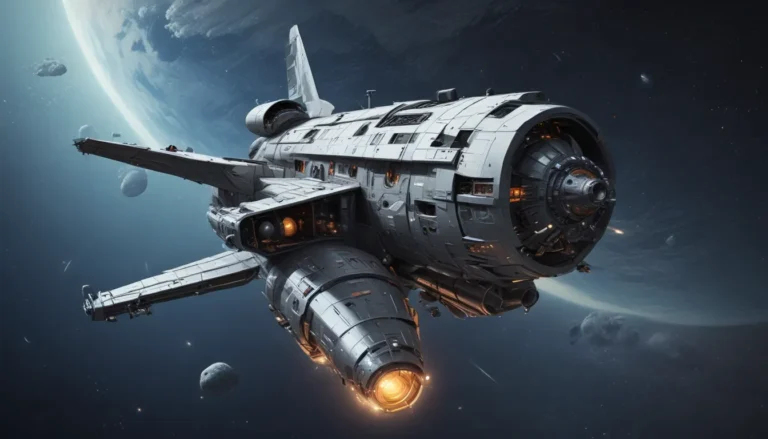The pictures we use in our articles might not show exactly what the words say. We choose these pictures to make you interested in reading more. The pictures work together with the words but don’t take their place. The words still tell you the important facts.
Space navigation systems are the unsung heroes of human exploration beyond Earth's orbit. These technological marvels are integral to guiding space missions, ensuring the safety of astronauts and unmanned spacecraft, and unlocking the mysteries of the universe. While we often gaze in awe at the vastness of space, it is equally captivating to delve into the intricate systems that enable us to navigate through it.
In this comprehensive guide, we will unveil 13 surprising facts about space navigation systems that showcase the ingenuity and complexity behind these incredible feats of engineering. From historical milestones to cutting-edge advancements, get ready to embark on a journey through the captivating world of space navigation.
The Marvels of Space Navigation Systems
Spacecrafts utilize a sophisticated combination of star trackers, gyroscopes, radio signals, and gravitational calculations to maneuver through the expanse of space. Let's explore the key components and functions of these navigation systems in detail:
Insight into Spacecraft Navigation Tools
- Spacecraft use star trackers: These high-precision instruments capture star patterns to determine the spacecraft's orientation and position accurately.
- Gyroscopes maintain stability: Gyroscopes play a crucial role in stabilizing spacecraft during lengthy missions by conserving angular momentum.
- Deep space missions rely on radio signals: When venturing far from Earth, spacecraft use radio signals to navigate accurately by measuring the time taken for signals to travel between the spacecraft and Earth-based antennas.
Navigating Through Space
- Utilizing celestial bodies as reference points: The Sun, Moon, and planets serve as essential markers for spacecraft navigation, enabling precise location calculations.
- Accounting for gravity: Space navigation systems incorporate gravitational forces from celestial bodies to ensure accurate trajectory calculations.
- Calculating velocity: By measuring the Doppler shift of radio signals, navigation systems can determine spacecraft speed for trajectory adjustments.
Advancements in Space Navigation Technology
- Autonomous navigation systems: Recent innovations have led to the development of autonomous navigation systems, allowing spacecraft to make real-time decisions independently.
- Gravity assists for trajectory alterations: By leveraging gravitational forces, space navigation systems can modify spacecraft trajectories efficiently, conserving fuel.
- Emphasis on precise timing: Accurate time measurements are crucial for determining spacecraft position and velocity during space missions.
Evolving Space Navigation Systems
- Continuous technological advancements: Space navigation systems are in a constant state of evolution, with scientists and engineers developing innovative techniques to enhance accuracy and efficiency.
- Thrusters for trajectory adjustments: Thrusters play a vital role in adjusting spacecraft trajectories, maintaining desired paths during extended space journeys.
- Adapting to atmospheric drag: Even in space, minimal atmospheric drag affects spacecraft, prompting navigation systems to factor this in for precise calculations.
Conclusion: Navigating the Cosmos
Space navigation systems embody the pinnacle of engineering prowess, revolutionizing human exploration of the cosmos. From GPS satellites to intricate celestial mechanics, these systems have empowered us to chart paths through the vastness of space. As we push the boundaries of our knowledge and embark on cosmic adventures, the evolution of space navigation systems continues to shape the future of space exploration.
As we gaze at the stars above, let's marvel at the intricate web of technology that propels us into the unknown. Remember these intriguing facts about space navigation systems and appreciate the extraordinary engineering behind every celestial voyage.
FAQs: Exploring Space Navigation
- How do space navigation systems work?
-
Space navigation systems utilize a mix of satellite-based positioning, celestial measurements, and advanced algorithms to ensure accurate spacecraft positioning.
-
Can space navigation systems be used beyond our solar system?
-
While primarily designed for intra-solar system navigation, ongoing research explores techniques for interstellar travel, presenting significant challenges.
-
How accurate are space navigation systems?
-
Modern systems boast remarkable positioning accuracy within a few meters, critical for precise spacecraft maneuvering and rendezvous.
-
How have space navigation systems advanced space exploration?
-
Space navigation systems have been instrumental in enabling spacecraft to reach distant planets, moons, and other celestial bodies, expanding our cosmic understanding.
-
What lies beyond the stars?
- The universe holds endless mysteries waiting to be uncovered, from ancient celestial navigation methods to orbital mechanics governing spacecraft trajectories. Embrace the excitement of cosmic discovery!
Your Trustworthy Space Exploration Companion
Our commitment to delivering engaging and credible content drives our mission to educate and inspire. Each fact on our platform is a testament to the diverse insights contributed by real users, meticulously reviewed by our dedicated editors for authenticity. Explore the wonders of space navigation with confidence, knowing that the information you discover is both fascinating and reliable.
Unlock the secrets of the cosmos and embark on a journey through the realms of space navigation. Let the wonders of the universe spark your curiosity and fuel your passion for exploration. The stars await your gaze, and the mysteries of space beckon you to delve deeper into the revelations of celestial navigation. Journey onward, and may your cosmic adventures be as awe-inspiring as the vast universe itself.






